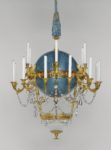 A magnificent gilded bronze chandelier with a uniquely whimsical design is the subject of a new exhibition at the Getty Center in Los Angeles. The Galle Chandelier was made in 1818-9 by bronze caster and gilder Gérard-Jean Galle in Paris. Acquired by the Getty in 1973, it has been on display at the Getty Center, one of the gems of its decorative arts collection, since 1997. Earlier this year it was removed for conservation and is now back on view in Flight of Fancy: The Galle Chandelier.
A magnificent gilded bronze chandelier with a uniquely whimsical design is the subject of a new exhibition at the Getty Center in Los Angeles. The Galle Chandelier was made in 1818-9 by bronze caster and gilder Gérard-Jean Galle in Paris. Acquired by the Getty in 1973, it has been on display at the Getty Center, one of the gems of its decorative arts collection, since 1997. Earlier this year it was removed for conservation and is now back on view in Flight of Fancy: The Galle Chandelier.
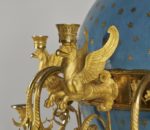 The new exhibition places the chandelier at eye-level so visitors can view the piece up close. On display along with it are images of some of the design details and prints and illustrations that explore Galle’s inspiration for the work. There are also be interactive video panels that will show a rendering of what the chandelier looked like with the candles lit.
The new exhibition places the chandelier at eye-level so visitors can view the piece up close. On display along with it are images of some of the design details and prints and illustrations that explore Galle’s inspiration for the work. There are also be interactive video panels that will show a rendering of what the chandelier looked like with the candles lit.
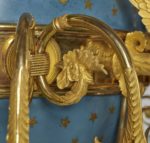 Gérard-Jean Galle came from a family of casters and gilders. His father Claude was one of the premier producers of gilded bronze of his time, creating works for Marie Antoinette, among others. The son took over the family business after his father’s death in 1815, but expensive decorative ornaments weren’t in high demand in post-Napoleonic France. The restored Bourbon monarchy was constitutional now and keen to distance itself from the dizzying spending and ostentation of the Ancien Régime. While what was left of the old nobility did return, they did so in highly reduced circumstances, their ancient feudal powers gone and their lands worked by people they actually had to pay. The new money, businessmen and the professional class, didn’t have the same passion for festooning shiny gold geegaws in every possible nook and granny.
Gérard-Jean Galle came from a family of casters and gilders. His father Claude was one of the premier producers of gilded bronze of his time, creating works for Marie Antoinette, among others. The son took over the family business after his father’s death in 1815, but expensive decorative ornaments weren’t in high demand in post-Napoleonic France. The restored Bourbon monarchy was constitutional now and keen to distance itself from the dizzying spending and ostentation of the Ancien Régime. While what was left of the old nobility did return, they did so in highly reduced circumstances, their ancient feudal powers gone and their lands worked by people they actually had to pay. The new money, businessmen and the professional class, didn’t have the same passion for festooning shiny gold geegaws in every possible nook and granny.
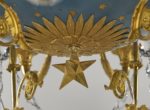 Galle’s skill and craftsmanship were certainly recognized. He won the silver medal at the 1819 Exposition des Produits de L’Industrie Française (Exhibition of French Products of Industry), but got little business from it. He tried the direct approach, writing a letter to Louis XVIII offering to sell the works he had exhibited at the Exposition for a price that would be “modest for the government.” The government declined.
Galle’s skill and craftsmanship were certainly recognized. He won the silver medal at the 1819 Exposition des Produits de L’Industrie Française (Exhibition of French Products of Industry), but got little business from it. He tried the direct approach, writing a letter to Louis XVIII offering to sell the works he had exhibited at the Exposition for a price that would be “modest for the government.” The government declined.
 One of those objects was a chandelier that was either the twin of the one owned by the Getty or the very same. Galle called it a lustre à poisson (fish chandelier) and described it thus in the letter:
One of those objects was a chandelier that was either the twin of the one owned by the Getty or the very same. Galle called it a lustre à poisson (fish chandelier) and described it thus in the letter:
Fish chandelier: In the middle of a blue enameled globe scattered with stars is a circle with the signs of the zodiac and six griffins carrying candles … [below is a glass bowl fitted with] a plug intended for the removal of the water which one places in the bowl with small goldfish whose continuous movement will give agreeable recreation to the eye.
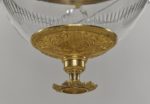 The idea of a live fish swimming in a bowl under a chandelier lit by 18 candles is certainly, uhh, innovative. I can’t imagine the fish would have had a good time of it. The globe design was a novelty as well. The gold zodiac symbols on the blue field remind me of the Montgolfier brothers’ historic hot air balloon which first took to the skies before King Louis XVI of France and Queen Marie Antoinette at Versailles in 1783.
The idea of a live fish swimming in a bowl under a chandelier lit by 18 candles is certainly, uhh, innovative. I can’t imagine the fish would have had a good time of it. The globe design was a novelty as well. The gold zodiac symbols on the blue field remind me of the Montgolfier brothers’ historic hot air balloon which first took to the skies before King Louis XVI of France and Queen Marie Antoinette at Versailles in 1783.
 Galle’s workshop stayed in business despite the royal refusal. He received a gold medal at the Exhibition of Products of French Industry in 1823 and finally did sale some of his pieces to Louis XVIII, earning the title fournisseur de sa majesté (supplier to his majesty), but it wasn’t enough to bring him any financial security. The Revolution of 1830 kneecapped his market yet again. He was forced to cut his workforce in half and the business ultimately went under. He died in poverty in 1846.
Galle’s workshop stayed in business despite the royal refusal. He received a gold medal at the Exhibition of Products of French Industry in 1823 and finally did sale some of his pieces to Louis XVIII, earning the title fournisseur de sa majesté (supplier to his majesty), but it wasn’t enough to bring him any financial security. The Revolution of 1830 kneecapped his market yet again. He was forced to cut his workforce in half and the business ultimately went under. He died in poverty in 1846.
Flight of Fancy: The Galle Chandelier will run through April 19th, 2020.
A design emphasizing Pisces may have been intended for someone with a birthday under that sign? I wonder if he intended to create chandeliers for each Zodiac sign.
Galle put all the signs of the zodiac on the chandelier. They’re on the gold band going around the “equator” of the globe. If you click on the picture of the whole chandelier, you’ll see Virgo and Libra on the front.
Thank you, Livius! It is an exquisitely lovely design and yes, it was inspired by the Montgolfier’s brothers hot air balloon, perhaps to create a bit of nostalgia for the aristocracy. Love your blog!
A beautiful piece of craftsmanship but I would so like to see it with the goldfish.
I am a Pisces so someone should get this for my birthday. You can send it belated. 😆